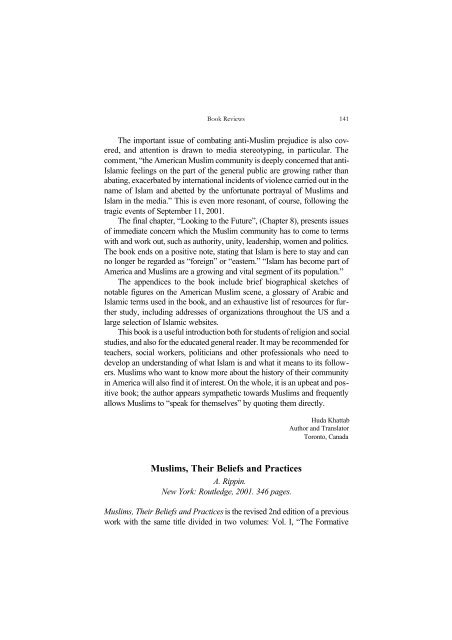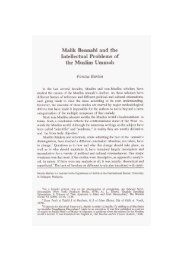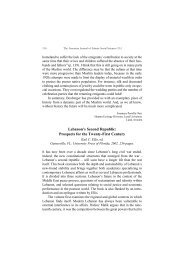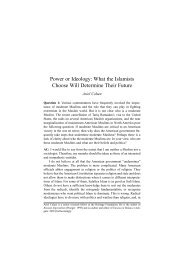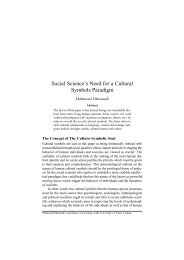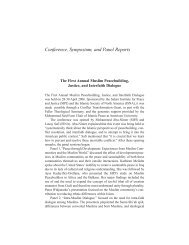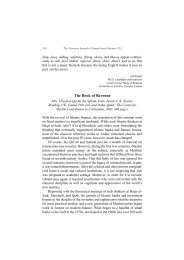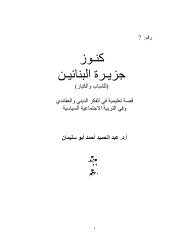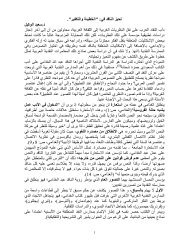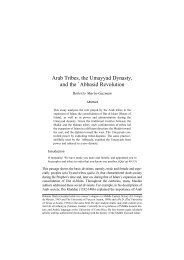Muslims, Their Beliefs and Practices - I-Epistemology
Muslims, Their Beliefs and Practices - I-Epistemology
Muslims, Their Beliefs and Practices - I-Epistemology
Create successful ePaper yourself
Turn your PDF publications into a flip-book with our unique Google optimized e-Paper software.
Book Reviews 141<br />
The important issue of combating anti-Muslim prejudice is also covered,<br />
<strong>and</strong> attention is drawn to media stereotyping, in particular. The<br />
comment, “the American Muslim community is deeply concerned that anti-<br />
Islamic feelings on the part of the general public are growing rather than<br />
abating, exacerbated by international incidents of violence carried out in the<br />
name of Islam <strong>and</strong> abetted by the unfortunate portrayal of <strong>Muslims</strong> <strong>and</strong><br />
Islam in the media.” This is even more resonant, of course, following the<br />
tragic events of September 11, 2001.<br />
The final chapter, “Looking to the Future”, (Chapter 8), presents issues<br />
of immediate concern which the Muslim community has to come to terms<br />
with <strong>and</strong> work out, such as authority, unity, leadership, women <strong>and</strong> politics.<br />
The book ends on a positive note, stating that Islam is here to stay <strong>and</strong> can<br />
no longer be regarded as “foreign” or “eastern.” “Islam has become part of<br />
America <strong>and</strong> <strong>Muslims</strong> are a growing <strong>and</strong> vital segment of its population.”<br />
The appendices to the book include brief biographical sketches of<br />
notable figures on the American Muslim scene, a glossary of Arabic <strong>and</strong><br />
Islamic terms used in the book, <strong>and</strong> an exhaustive list of resources for further<br />
study, including addresses of organizations throughout the US <strong>and</strong> a<br />
large selection of Islamic websites.<br />
This book is a useful introduction both for students of religion <strong>and</strong> social<br />
studies, <strong>and</strong> also for the educated general reader. It may be recommended for<br />
teachers, social workers, politicians <strong>and</strong> other professionals who need to<br />
develop an underst<strong>and</strong>ing of what Islam is <strong>and</strong> what it means to its followers.<br />
<strong>Muslims</strong> who want to know more about the history of their community<br />
in America will also find it of interest. On the whole, it is an upbeat <strong>and</strong> positive<br />
book; the author appears sympathetic towards <strong>Muslims</strong> <strong>and</strong> frequently<br />
allows <strong>Muslims</strong> to “speak for themselves” by quoting them directly.<br />
<strong>Muslims</strong>, <strong>Their</strong> <strong>Beliefs</strong> <strong>and</strong> <strong>Practices</strong><br />
A. Rippin.<br />
New York: Routledge, 2001. 346 pages.<br />
Huda Khattab<br />
Author <strong>and</strong> Translator<br />
Toronto, Canada<br />
<strong>Muslims</strong>, <strong>Their</strong> <strong>Beliefs</strong> <strong>and</strong> <strong>Practices</strong> is the revised 2nd edition of a previous<br />
work with the same title divided in two volumes: Vol. I, “The Formative
142 The American Journal of Islamic Social Sciences 19:1<br />
Period,” published in 1990, <strong>and</strong> vol. II, “Contemporary Period,” which<br />
appeared in 1993. The present issue, like the preceding one, is a synthesis of<br />
the development of Islam throughout its history, from the 7th to the 20th<br />
century, with an insight into the challenges of the future. The author makes<br />
a review of <strong>Muslims</strong>’ perceptions of their religion as well as the scholarly<br />
activity – by <strong>Muslims</strong> <strong>and</strong> non <strong>Muslims</strong> – dedicated to it. This critical attitude<br />
distinguishes the book from other introductions to Islam. According to<br />
its bibliography, the book is addressed to an audience deemed reluctant as<br />
regards to languages other than English. Yet the style <strong>and</strong> content of the book<br />
make of it a complicated reading for a lay public who tries a first approach<br />
to Islam.<br />
<strong>Muslims</strong>, <strong>Their</strong> <strong>Beliefs</strong> <strong>and</strong> <strong>Practices</strong> is organized in six parts, each one<br />
introduced by a list of the most significant dates for the subject matter in<br />
question. Practical examples excerpted from the sources or the author’s personal<br />
experience are used to illustrate his arguments. Notes appear at the<br />
end. Subsequently, the reader is provided with a glossary, a bibliography<br />
additional to that mentioned in the notes, a list of websites of use for students<br />
of Islam, a thematic index <strong>and</strong> finally, an index of Qur’anic citations.<br />
Part I, “Formative Elements of Classical Islam,” contains three chapters.<br />
Chapter 1, “Prehistory”, covers the 6th century, a period in the history of<br />
Arabia on which research about the constituent elements of the new religion<br />
has focused. For his part, Rippin puts forward a gradual process from the 6th<br />
to the 8th centuries in the broader spatial context of the Near East as a more<br />
suitable model to underst<strong>and</strong> the emergence of Islam. In Chapter 2, “The<br />
Qur’an,” the author describes its form <strong>and</strong> content. Going further, he poses<br />
the questions of how, why <strong>and</strong> when the Qur’an became a text with the<br />
aspect it has today. Chapter 3, “Muhammad,” discusses the problems of the<br />
historicity of the Prophet’s biography as well as its significance.<br />
Part II, “The Emergence of Islamic Identity,” includes four chapters.<br />
Chapter 4, “Political action <strong>and</strong> theory,” turns around three subjects: (a) the<br />
role of religion in the territorial expansion of the Arabs, (b) the role of politics<br />
in the enunciation of the classical form of Islam, <strong>and</strong> (c) the final separation<br />
between both the religious <strong>and</strong> the political spheres with the emergence<br />
of the class of the religious scholars (ulama). The latter assumed the<br />
formulation of Islamic faith <strong>and</strong> law: a process analyzed in chapters 5,<br />
“Theological Exposition,” <strong>and</strong> 6, “Legal Developments,” respectively. His<br />
treatment of these aspects appears rather influenced by the writings of P.<br />
Crone, M. Hinds <strong>and</strong> N. Calder. Chapter 7 is dedicated to the description <strong>and</strong><br />
interpretation of Islam’s external face: “Ritual Practice.”
Book Reviews 143<br />
Part III, “Alternative Visions of Islam,” contains chapter 8, “The Shi>a”,<br />
<strong>and</strong> chapter 9, “Sufi devotion.” Rippin underlines the symbolic value of the<br />
differences between Shi>is <strong>and</strong> Sunnis <strong>and</strong> their political functionality. With<br />
respect to Sufis, the author concludes that they have represented more than<br />
an alternative, a supplement, to the Islamic way of life.<br />
In Part IV, “Consolidation of Islamic Identity,” the constant re-elaboration<br />
of the literary tradition of Islam is presented as an effort to respond to<br />
the reality that has also led to the consolidation of an Islamic identity.<br />
Chapter 10, “Intellectual culture,” addresses the non-religious sciences in<br />
the classical period. Chapter 11, “Medieval Visions of Islam,” covers the<br />
process of reinterpretation of Islamic traditional disciplines in the post-classical<br />
period (13th-18th centuries).<br />
Part V, “Modern Visions of Islam,” is the longest part of the book. It is<br />
distributed in four chapters: chapter 12, “Describing Modernity,” focuses on<br />
the impact of western colonization of Muslim l<strong>and</strong>s. Rippin also insists on<br />
the need to pay attention to Islam’s internal dynamics, <strong>and</strong> situates the definitions<br />
of modernity, post-modernity <strong>and</strong> tradition in the Islamic context.<br />
How have <strong>Muslims</strong> responded to the challenges of modernity? By means of<br />
a recreation of the figure of Muhammad, a question analyzed in chapter 13,<br />
“Muhammad <strong>and</strong> Modernity.” Also by means of a constant reinterpretation<br />
of the Qur’an, illustrated in chapter 14, “The Qur’an <strong>and</strong> Modernity.” In<br />
chapter 15, “Issues of Identity,” the significance of the Islamic identity<br />
nowadays as well as the evolution experienced in its defining elements is<br />
examined. In this area, Rippin sees a tendency towards a “personalization of<br />
the faith” in which the ritual practices have been given a new meaning.<br />
Part VI, “Revisioning Islam,” contains chapters 16 “Feminism’s Islam”<br />
<strong>and</strong> 17, “Visions for Islam in the Twenty-first Century <strong>and</strong> Beyond”.<br />
Chapter 16 addresses Islam’s response to change in the traditional family<br />
structure <strong>and</strong> the role of women in society. Chapter 17 is an attempt to outline<br />
the main challenges that Islam will have to face in the 21st century,<br />
challenges which, this time, are posed by dissenting voices from inside the<br />
Muslim community. What the future generations of <strong>Muslims</strong> will make of<br />
this potential, concludes Rippin, is uncertain. Finally, he points to the convenience<br />
of seeing Islam, like other religions, “on a continuum, attempting<br />
self-conscious definition at times <strong>and</strong> reaching into the experiential dimension<br />
of religion in order to refresh those definitions at other times.”<br />
The preceding sketch can hardly do justice to the content of a work so<br />
rich <strong>and</strong> suggestive as Rippin’s. His is a highly commendable book, which<br />
combines the effort to synthesize a complex <strong>and</strong> vast phenomenon like
144 The American Journal of Islamic Social Sciences 19:1<br />
Islam with sharp criticism <strong>and</strong> a projection into the future. All works of synthesis<br />
have shortcomings, however: not all the facts that we judge as relevant<br />
are included; <strong>and</strong> bibliographical references are not always those we<br />
would have expected. This was particularly evident for me as regards<br />
Islamic law: Rippin has not followed the results of recent studies on the<br />
subject; his treatment of the subject, “the application of Islamic law in the<br />
Middle ages,” is obsolete.<br />
To these “natural” <strong>and</strong> somehow unavoidable limitations I would like<br />
to add the following remarks:<br />
In his foreword, Rippin declares his intention to concentrate on the<br />
Arab-Persian Empire to study the classical period of Islam, in the Near<br />
East, the Indian subcontinent, Malaysia, North America <strong>and</strong> Europe for the<br />
modern period. Yet this focus responds more to the training <strong>and</strong> interests of<br />
the author than the fact that the most important events might actually have<br />
taken place in those geographical areas. As a consequence of this method,<br />
Islam is portrayed as the receptor of a variety of external influences, while<br />
the influences it exerted over other religions are ignored.<br />
To be precise, I am referring to the process operated through the Muslim<br />
West by means of which the Islamized Greek thought passed to Europe,<br />
affecting not only scientific <strong>and</strong> philosophical knowledge but also theological<br />
speculation. In this connection, the name of the physician, philosopher,<br />
theologian <strong>and</strong> jurist Averroes can in no way be omitted. This omission is all<br />
the more surprising when we see that Rippin has taken into account other<br />
prominent Andalusian figures such as the Zahiri jurist, Ibn Hazm, <strong>and</strong> the<br />
Sufi, Ibn al-`Arabi. The existence of “Purification Movements” is traced<br />
back to Ibn Taymiyya (13th century). However we have examples of much<br />
earlier manifestations of this tendency with the Almoravids (last quarter of<br />
the 11th century) <strong>and</strong> the Almohads (second half of 12th century).<br />
Another negative consequence of Rippin’s delimitation of his subject<br />
appears in his treatment of Sufism. The movement is presented as if it had<br />
never entered the political scene before the 16th century. However, it is<br />
known that in the first half of the 12th century, the Sufi order known as the<br />
Muridun, led by Ibn Qasi, seized power against the Almoravids in the western<br />
region of al-Andalus. Moreover, Rippin refers to the use that some<br />
Islamists made of the figure of the Hanbalite Damascene Jurist, Ibn Taymiyya,<br />
while he silences some modernists’ resource to the Malikite<br />
Granadan jurist al-Shatibi.<br />
The term mufti, legal expert who issues non-binding advisory opinions,<br />
is erroneously rendered as judge. My final comment relates to the discussion
Book Reviews 145<br />
on the fabrication of prophetic traditions. According to I. Goldziher, J.<br />
Schacht <strong>and</strong> G.H.A. Juynboll, these reports were a late artificial elaboration<br />
gradually projected back to the Prophet’s era. These opinions appear to be<br />
still admitted by a majority of scholars. However, I have missed some reference<br />
to W. Hallaq, H. Motzki, D. Powers, <strong>and</strong> U. Rubin, who have recently<br />
questioned them.<br />
Delfina Serrano Ruano C.S.I.C.<br />
Instituto de Filologia, Departamento de Estudios Arabes<br />
Madrid, Spain<br />
Perspectives on Islamic Law, Justice <strong>and</strong> Society<br />
R .S. Khare, ed.<br />
Lanham, MD: Roman <strong>and</strong> Littlefield Publishers, Inc., 1999. 207 pages.<br />
This short, 207 page book is a refreshing overview of Islamic legal principles<br />
<strong>and</strong> new trends within Islamic societies. Though Islamic law has often<br />
been viewed as a sluggish monolith, it is actually a rather dynamic field.<br />
R.S. Khare has assembled a number of distinguished academics to discuss<br />
Islamic law, not as a homogenous entity, but rather in light of the reality:<br />
that Islamic law is multi-faceted, varied, highly regional <strong>and</strong> must be<br />
viewed in light of historical changes.<br />
Thus, this collection of essays focuses upon the manner in which<br />
Islamic law, as an organic law, is constantly reconciling historically changing<br />
socio-economic conditions with modernity <strong>and</strong> technology. The collection<br />
is organized in three parts. The first part outlines the concept of Islamic<br />
law, formal legal institutions <strong>and</strong> traditional Islamic scholarship. The second<br />
portion of the book focuses on the regionalism of Islamic law <strong>and</strong> the<br />
manner in which the colonial period had a provocative impact upon the<br />
evolution <strong>and</strong> endurance of certain Islamic legal institutions. The final portion<br />
of the collection uses two interesting cases in which modernity <strong>and</strong><br />
technology are problematizing <strong>and</strong> calling for a fundamental rethinking of<br />
seemingly “basic” principles.<br />
The unifying theme of the essays is the manner in which Islamic societies<br />
today are dealing with modernity <strong>and</strong> the manner in which technological<br />
advancements <strong>and</strong> global changes affect Islamic societies <strong>and</strong> concepts<br />
within Islamic law. Though at times the collection seems fragmented due to<br />
the different disciplines of the authors, this variety allows for a solid <strong>and</strong><br />
nuanced underst<strong>and</strong>ing of the issues.


